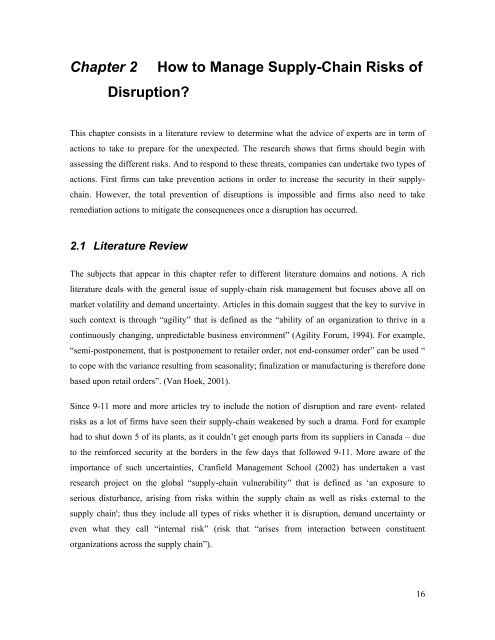Managing Risks of Supply-Chain Disruptions: Dual ... - CiteSeerX
Managing Risks of Supply-Chain Disruptions: Dual ... - CiteSeerX
Managing Risks of Supply-Chain Disruptions: Dual ... - CiteSeerX
You also want an ePaper? Increase the reach of your titles
YUMPU automatically turns print PDFs into web optimized ePapers that Google loves.
Chapter 2Disruption?How to Manage <strong>Supply</strong>-<strong>Chain</strong> <strong>Risks</strong> <strong>of</strong>This chapter consists in a literature review to determine what the advice <strong>of</strong> experts are in term <strong>of</strong>actions to take to prepare for the unexpected. The research shows that firms should begin withassessing the different risks. And to respond to these threats, companies can undertake two types <strong>of</strong>actions. First firms can take prevention actions in order to increase the security in their supplychain.However, the total prevention <strong>of</strong> disruptions is impossible and firms also need to takeremediation actions to mitigate the consequences once a disruption has occurred.2.1 Literature ReviewThe subjects that appear in this chapter refer to different literature domains and notions. A richliterature deals with the general issue <strong>of</strong> supply-chain risk management but focuses above all onmarket volatility and demand uncertainty. Articles in this domain suggest that the key to survive insuch context is through “agility” that is defined as the “ability <strong>of</strong> an organization to thrive in acontinuously changing, unpredictable business environment” (Agility Forum, 1994). For example,“semi-postponement, that is postponement to retailer order, not end-consumer order” can be used “to cope with the variance resulting from seasonality; finalization or manufacturing is therefore donebased upon retail orders”. (Van Hoek, 2001).Since 9-11 more and more articles try to include the notion <strong>of</strong> disruption and rare event- relatedrisks as a lot <strong>of</strong> firms have seen their supply-chain weakened by such a drama. Ford for examplehad to shut down 5 <strong>of</strong> its plants, as it couldn’t get enough parts from its suppliers in Canada – dueto the reinforced security at the borders in the few days that followed 9-11. More aware <strong>of</strong> theimportance <strong>of</strong> such uncertainties, Cranfield Management School (2002) has undertaken a vastresearch project on the global “supply-chain vulnerability” that is defined as ‘an exposure toserious disturbance, arising from risks within the supply chain as well as risks external to thesupply chain'; thus they include all types <strong>of</strong> risks whether it is disruption, demand uncertainty oreven what they call “internal risk” (risk that “arises from interaction between constituentorganizations across the supply chain”).16
















